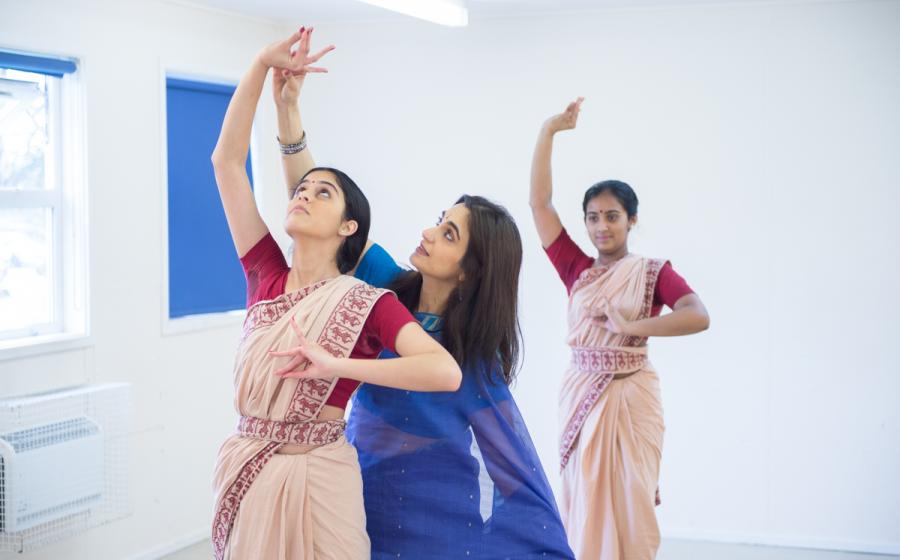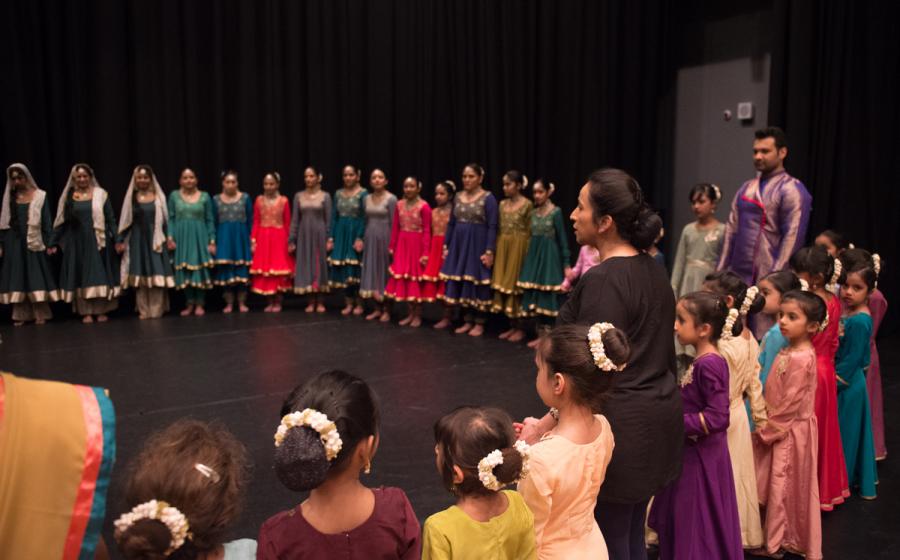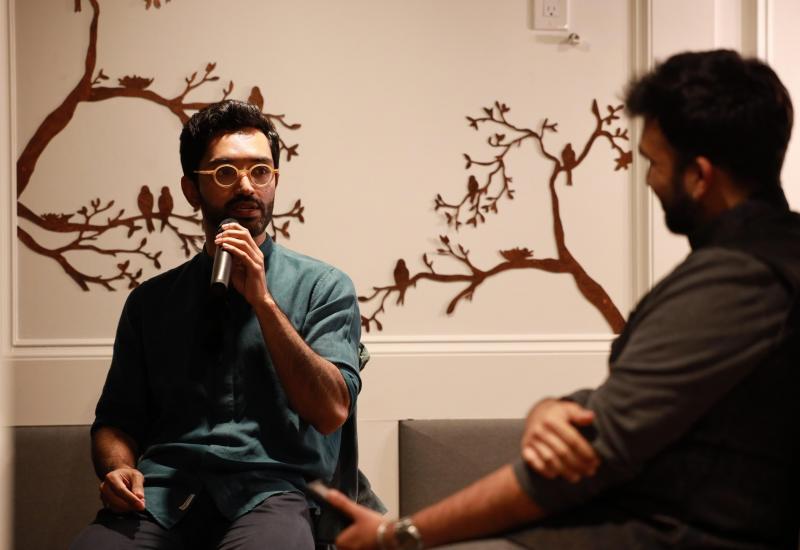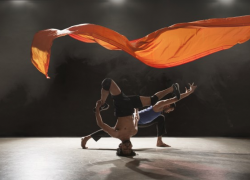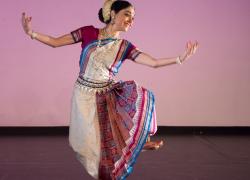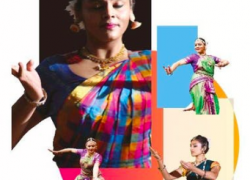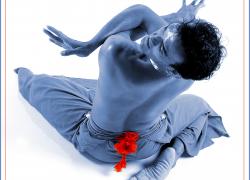Does the guru-shishya model of dance teaching hold out the best prospect of creating a performer?
'We have found that it is only up to a level that you can teach students as a group. Each one’s experience, imagination and capacity is different. This can be enhanced only by one to one experience through the guru-shishya tradition whether in music or dance...'
'...Look at the situation – if Anoushka Shankar were to go to a school, rather than learning from her father… or Padma Subramanyam’s brother’s granddaughter, Mahathi were to have learned at a school, would they have reached the levels they have done? School is fine up to a point, but certain aspects of teaching are beyond school learning. School is important, but later the guru-shishya tradition becomes important. So, the two ways of learning are complementary.' (M. Nandakumara, Interview 2018)
As this observation shows, for Nandakumara, Director of the Indian classical arts centre the Bharatiya Vidya Bhavan, the answer to the question posed in the title is clear. On the basis of his experience of working with arts students for many years, he feels that it is indeed the guru-shishya model of teaching that is able to nurture the best performers.
Dancer, choreographer and teacher Urja Desai Thakore’s response is more equivocal:
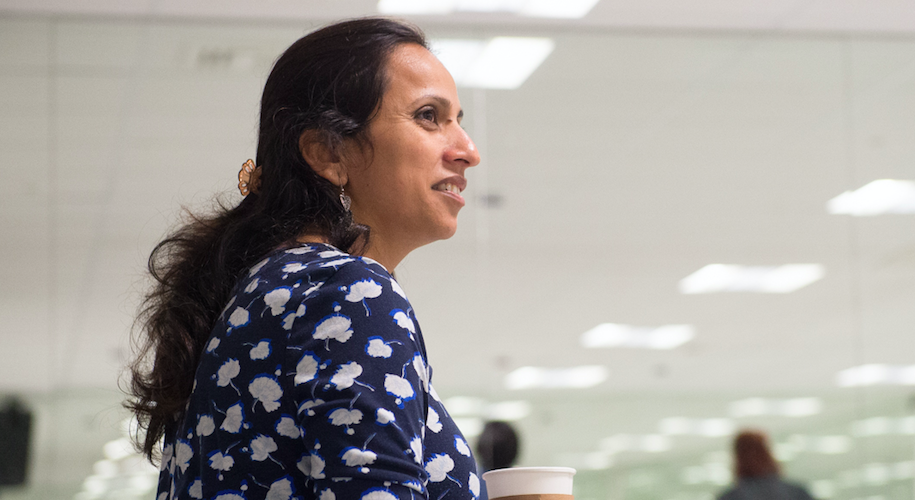
Urja Desai Thakore | Image credit: Simon Richardson
'I don’t think so. A good teacher can create a good performer. Also, a performer has to invest from his side or her side. So, I don’t think it is down to the guru-shishya model, but rather, the more you invest in your learning as a student, the more you are samarpit (dedicated, committed) to learning, then you can be a good performer… and of course, the teacher has to be giving…' (Urja Desai Thakore, Interview 2019)
I will return to these apparently divergent views later. The context of the question is a debate around the continued relevance and efficacy of the guru-shishya model of teaching that crops up perennially within the world of South Asian dance in Britain. This is unsurprising, given the significance this model of teaching has held and continues to hold for Indian performing arts as ‘a master paradigm that runs like a leitmotif through India’s checkered history’ (T.G. Vaidyanathan, cited in Grimmer: 2011:91).
The specific question about its role in creating performers immediately begs two further questions. First, what exactly do we mean by the guru-shishya model of teaching in a context far removed from the time, place and socio-economic conditions in which it first developed? And, second, what kind of performer do we want to create?
Is the system one that can exist any more?
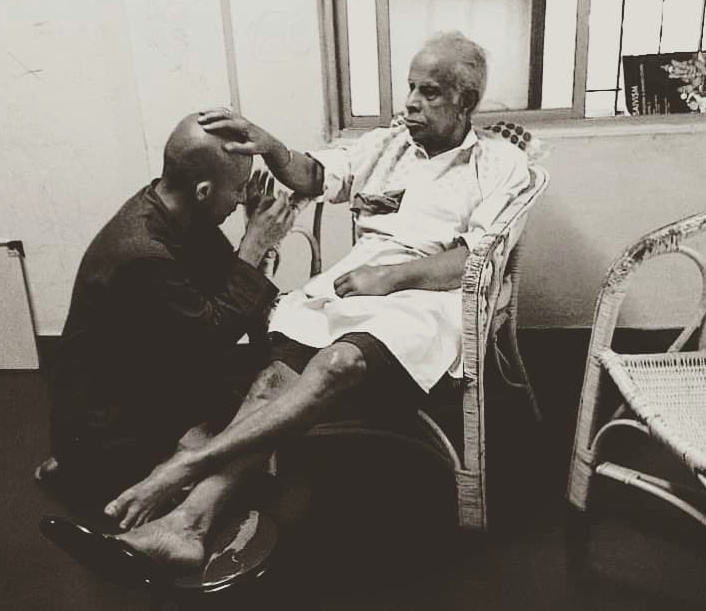
Mavin Khoo with Guru Adyar Lakshman | Image credit: Lucrezia Maniscotti
As is well known, a distinctive feature of the guru-shishya tradition that was used to transmit training in the arts for several generations if not centuries, was gurukulavasam whereby the student (shishya) lived as a part of the guru’s household for a number of years, receiving formal instruction, but also absorbing the myriad of details and influences that serve to make a professional performer. In other words, it was an immersive training over a prolonged length of time. In this light, Mavin Khoo, though a product of the guru-shishya tradition himself, and committed to the ideal it represents, questions whether given the economic and temporal constraints of the modern world, the system is one that ‘can exist anymore?’ (Khoo Interview, 2017, cited in Gorringe, Jarret-Macauley and Srivastava, 2018: 84). Nina Rajarani raises a related concern: ‘The term is used too casually…this is a lot more serious and involved than just a weekly class’ (Rajarani, Interview 2019). A contemporary version of the guru-shishya model, to bear some resemblance to its precursor, should involve some element of ‘shadowing’ one’s teacher over a prolonged period, so as to imbibe the art form as much through observation and osmosis as through formal tuition.
For several successful performers in Britain today, despite its contemporary limitations, the guru-shishya tradition has provided a launchpad for their work precisely because it has done this. Their experience of the tradition is of an emphasis on training that certainly goes substantially beyond ‘just weekend classes’. For them, while they no longer spend several years in immersive apprenticeship to a teacher, the tradition offers training that ‘is not confined to the classroom’ (Vidya Patel Interview 2019), that ‘is not restricted to hours and bureaucracy of institutionalised spaces’ and that transcends the ‘financial model’ (Shane Shambhu Interview 2019). Both Shambhu and Patel have been, albeit for short periods, members of their guru’s household, as the relationship with their teacher has developed to the point where this has seemed both natural, and the best way to facilitate their onward training. For them, despite the limits on the duration of these times, the intensity offered during these periods has been invaluable.
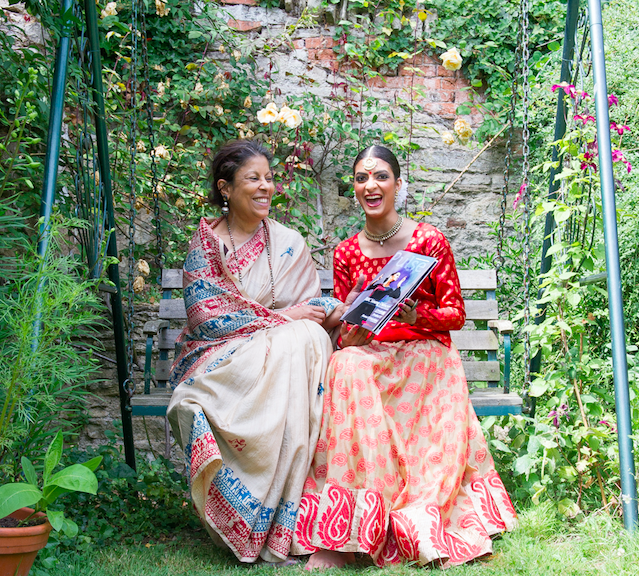
Vidya Patel with Guru Sujata Banerjee | Image credit: Simon Richardson
A prominent example of an immensely successful and highly creative performer, who acknowledges the role of the guru-shishya tradition in his development is of course Akram Khan who frequently acknowledges his debt to his guru Pratap Pawar, specifying that ‘that he was Pawar’s student from age eight to 17, at which time he became Pawar’s shishya’ (Purkayastha, cited in Prickett 2007: 35). Khan’s specification is telling, because it flags the distinction as he sees it between being a ‘student’, and being a shishya, committed to the service of his art form under the guidance of his guru. In the earlier guru-shishya tradition, there was a formal dedication ceremony, and you became a shishya immediately on entering the gurukul, since your commitment to the art form as a way of life was thenceforth taken as read. In the contemporary world however, in a context where children are brought to dance classes to keep in touch with their culture, or to keep fit, or to work towards increasing their UCAS points, it is not so clear cut when the relationship with a teacher becomes a relationship with a guru. After all, as Shambhu points out, ‘we don’t have highway road signs announcing, ‘You are now entering the guru-shishya tradition’ (Shambhu Interview 2019). At a certain point in their relationship however, each of these performers felt a gear change in this relationship – and this has clearly nurtured their development as artists.
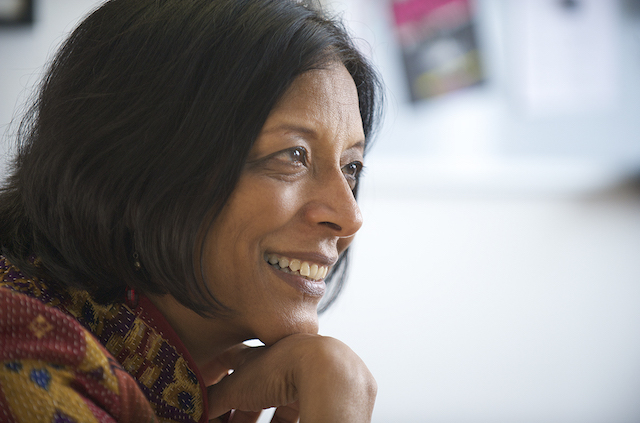
Shobana Jeyasingh| Image credit: Simon Richardson
As a counterpoint (true to the title of one of her works!), Shobana Jeyasingh, separating the guru-shishya tradition from the ideology that surrounds it, makes the very straightforward point that, ‘I think having an inspiring teacher is important for all forms of dance. And I think especially for the arts you do have a bond with people who have actually taught you something amazing about your art form’ (Jeyasingh Interview 2018). It is important to bear in mind, she cautions, that ‘having a very inspirational teacher to whom you are loyal and devoted is not a monopoly of Indian dance’. She cites the example of Robert Cohan, ‘a very inspiring teacher…I have met so many people who have been his students who obviously love him and are incredibly loyal and are devoted to him as a teacher’ (Ibid). While not labelled a guru-shishya relationship, the relationship Cohan had with some of his students clearly shares some of its characteristics – and the same is true of teachers throughout the world of Western contemporary dance and ballet.
Indeed, in the absence of the clearly distinctive feature of the gurukulum, it is arguable that the difference between ‘guru’ and ‘teacher’ is semantic. The person some perceive as a guru, others simply perceive as a teacher. Returning to the opening quotations for example, Nandakumar’s perceives one to one tuition is as belonging to the guru-shishya tradition, where for Thakore, whether she teaches her students in groups or one to one, she is happier to be not their ‘guru’ but their teacher. The complexities of definition are reinforced by Thakore’s experience of being introduced by others as a ‘guru’. At what point does a guru become a teacher, and for whom?
The sense that whatever the choice of words, those who choose ‘guru’ and those who choose ‘teacher’ may ultimately be referring to the same thing is bolstered by an understanding of the guru-shishya tradition which allows for multiple gurus. Nina Rajarani explains – ‘Long ago, you would attach to one guru for life. Now you can have one person as a guru and learn from others. Even beyond this, when I analyse my own training, I feel that in addition to Guruji (Prakash Yadagudde), I feel that I must count both the Dhananjayans and Chitra Visweswaran as my gurus.’ (Rajarani Interview 2019) In discussion with Visweswaran, the latter also felt that it is possible to have more then one guru. Bharatanatyam dancer Swati Seshadri agrees. For her a guru is particularly a teacher who is ‘witness to growth and witness to significant change and progress in your development as an artist.’ In this light she feels that you can have ‘multiple gurus at the same time and over time’ (Seshadri interview 2019). For Patel, ‘I think it is possible to have more than one guru, but for me anyway, there will always be one main guru.’ Nonetheless, ‘didi is always open for me to learn with others…for example, she has arranged tabla classes for me in India. She made the first contact, and then I spoke to the teacher, but under the auspices of Sujata. She has sent me to learn from other colleagues, but it is always with her knowledge’ (Patel Interview 2019). Dancer, choreographer and teacher Stella Subbiah, while unconvinced by the notion of multiple gurus, is none the less clear that you can receive training from multiple teachers, while under the tutelage and direction of a single guru. For Subbiah, ‘I feel that if I invite people into my space (rather than sending them away to learn from other people), I can facilitate their learning’ (Subbiah Interview 2018). Such a notion of training with a number of teachers, though under the auspices of one guru is nothing new – several leading performers in bharatanatyam for example, while training with one main guru, would enhance their understanding of abhinaya through classes with Kalanidhi Narayan (Kalanidhi mami).
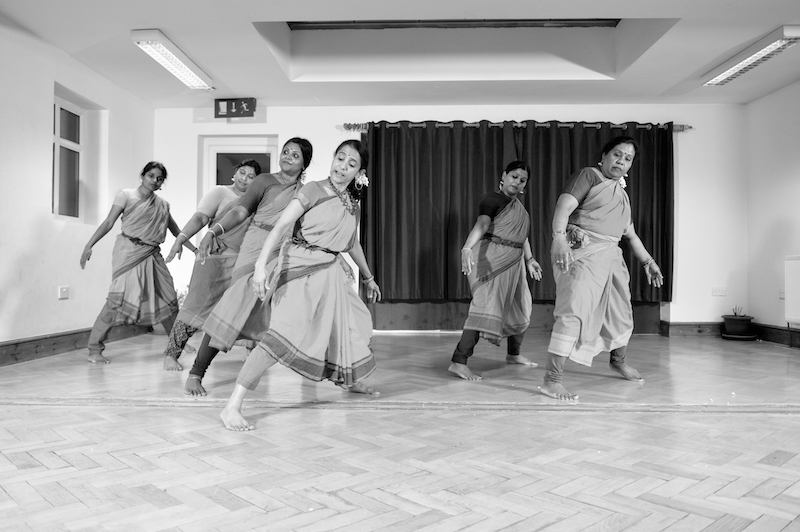
Stella Subbiah with Adult learners | Image credit: Courtesy the artist
At this point, at least for classical Indian dance tuition within the UK, the question that forms the basis of this discussion becomes academic. As there is no vocational training school, and very few professional class opportunities, the only option for intensive training is with a primary teacher (with whom one would normally develop a long standing and meaningful relationship), with the potential to attend further class and absorb different influences from others. In this context, whether this relationship is labelled that of ‘teacher and pupil’ or ‘guru and shishya’ is surely a moot point.
One difference between ‘guru’ and ‘teacher’ that goes beyond the semantic is the ideology that undergirds the understanding of the ‘guru’, an ideology that stems from and pervades Hindu scriptures, from as far back as the Vedas (Mlecko 1982). The ‘guru’ referred to in these texts is usually a spiritual guide (hence the folk etymology ‘gu’ ‘ru’ or dispeller of darkness) rather than a teacher of an art or craft. Along with the term, the arts absorbed the rhetoric surrounding the ‘guru’, both the affirming (e.g. ‘ the guru is the one who blesses and enhances the spiritual seeker’s life, Yajur Veda ( VII, 27), cited in Mlecko 1982: 35) and the disciplinarian ( e.g. ‘He (the Sisya) shall approach his teacher with the same reverence as a deity, without telling idle stories, attentive and listening eagerly to his words, Apastamba I, 2, 6, 13, cited in Mlecko 1982: 39). There are many other such injunctions specifying service and obedience to the guru, particularly in Dharmasutras such as the Apastamba or the Manusmrti (Laws of Manu). It is the playing out of this kind of disciplinarian rhetoric that leads Thakore to wish to distance herself from the tradition. Though her experience with her own guru was very different (‘it was rather Kumi behn who was looking after me!’) she has been ‘shocked and surprised’ to see other instances where ‘gurus were ordering their students around. The expectation to demean someone – to ask them to fetch things, to press legs… I don’t want to be a guru because once you get the title you start expecting a lot.’ (Thakore Interview 2019). Far from holding out the best prospect of creating a performer, such instances of the abuse of a guru’s power can end up, as Rajarani points out, ‘coming in the way of the shishya excelling…if the guru is insecure and afraid of losing their student and so refuses permission for the shishya to work with someone else while they themselves are unable to provide the skills and experience that the shishya needs’ (Rajarani Interview 2019). In the most extreme cases, and it is important to raise this, especially in the light of the recent #MeToo movement, the rhetoric of complete obedience and service can leave a student open to still worse kinds of abuse.
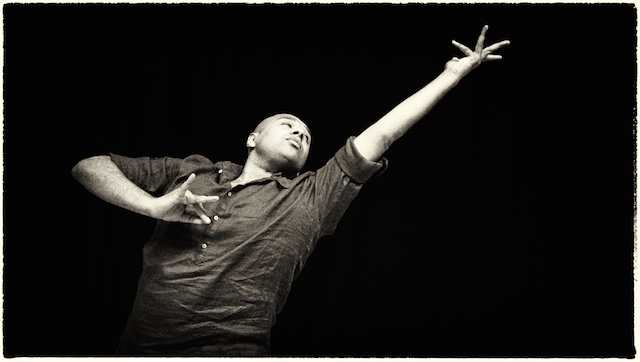
Shane Shambhu | Image credit: Simon Richardson
In the light of this, and given that the most distinctive feature of the tradition (gurukulavasam) has largely died out, there is obviously a question about whether the term should continue to be used at all. And yet, all institutions and traditions are liable to corruption because they are embodied in people, and should such instances of exploitation and corruption mean a wholesale abandoning of the spirit of the tradition? There is a reason that the word ‘guru’ has entered the English language – it is because there is no equivalent word that quite summarises that combination of teacher, mentor, guardian and friend that the word (at its best) represents. Nurturing a relationship with someone who can prove ‘the rock that you go back to talk about the industry with and to talk about your development… a constant sounding board’ ( Seshadri interview 2019); ‘ with whom you grow and understand yourself better’ (Shambhu 2019), who helps you to ‘fill… time with meaningful activity’ (Patel interview 2019) can only be a bonus, helping to provide a steering rudder through uncharted waters. A committed relationship with someone who can guide you in your development as an artist will self-evidently both enhance your character as a performer, and quite likely increase your opportunities to perform.
At the start of this article, I raised two further questions in relation to the core question addressed. One about what we might mean by the guru shishya tradition, which I have discussed at length, and the other about the nature of performer we are hoping to create. To briefly consider this question, a further reason for the importance of a one to one relationship between teacher and dancer within Indian classical dance is that so much of our work (indeed some would say, the apogee of our work) is as a solo artist performing intricate and emotionally involved work such as a varnam. For such work, a mentor or a coach can clearly play a vital role, and this coach is often the student’s regular teacher (guru). For work involving group choreography however, the efficacy of a guru in making a good performer would very much depend on whether that guru explores such choreography themselves, or encourages their students to do so in other contexts. Furthermore, in Britain today, many performance opportunities are dependent as much as anything upon versatility, in which case the best option for a performer would include an aspect of training in Western contemporary dance (as, obviously was the case for Akram Khan).
By way of a summary, if not a conclusion, though a different entity to its precursor, in its emphasis on commitment and regular practice, as well as in its representation of a relationship which at is best can offer students ‘a are a constant sounding board’ from someone who has seen you [artistically] grow the most (Seshadri Interview 2019), the contemporary guru- shishya relationship (what Prickett labels the ‘neo – guru’: Prickett 2007) can provide a solid base for a performer’s development. This is clearly not the only, or even necessarily the best way of creating a performer, as immersive, holistic training in an institution such for example as Kalakshetra can clearly create excellent performers. In this case, the idea of the guru-shishya tradition undergoes yet another reformulation, as Kalakshetra’s presiding spirit or overall guru is Rukmini Devi, whose values are incorporated into the institution and adopted by those working there (Subbiah 2019). The situation in Britain today, however is that the combination of sustained learning under one teacher with in put from others is the best model we have for the simple reason that we have at present no other way to offer intensive or vocational training. As we have seen, for some this relationship merits the title guru-shishya, while others are more comfortable with the less loaded understanding of ‘teacher and student’. Whether your skill as a performer then translates to success in a dance world coded to Western contemporary dance and ballet is a different question, as indeed is the concept of success, in whose world and on whose terms. Returning to the very first meaning of the guru-shishya tradition as a means towards self-understanding, wisdom, and a sense of one’s place within a far greater reality (that some call God), the best performer is surely someone who can perform for no other reason than to embody the forms more fully and more perfectly so that, in Yeats’ phrase, we cannot ‘tell the dancer from the dance’. How far such performance is facilitated or inhibited by the pursuit of professional success as a performer is a debate for another time.
Acknowledgements
I very gratefully acknowledge the contributions of all those cited in this article, especially (for the discussion of this particular question), Urja Desai Thakore, Vidya Patel, Nina Rajarani (MBE), Swati Seshadri, Shane Shambhu and Stella Subbiah. Their conversations have helped shape this work, and to that extent its authorship is as much theirs as mine. Some of the interviews on which this article is based were conducted in the course of my PhD research at the University of Roehampton generously funded by a Vice Chancellor's scholarship.The responsibility for any faults or omissions is mine alone.

